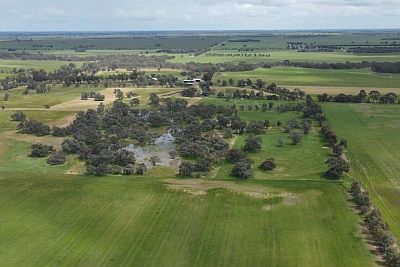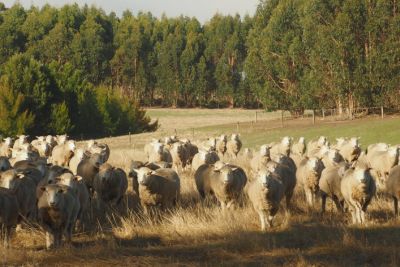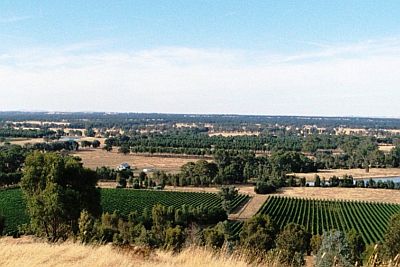SWIFFT Seminar notes 27 July 2023
Agriculture supporting biodiversity
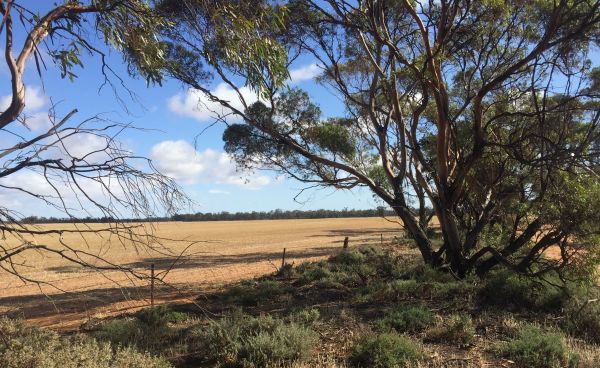
SWIFFT seminar notes are a summary of the seminar and not intended to be a definitive record of presentations made and issues discussed.
This SWIFFT seminar was conducted online with 228 participants via Microsoft Teams. SWIFFT wishes to acknowledge support from the Department of Energy, Environment and Climate Action (DEECA), Victoria in organising the seminar and thank speakers for their time and delivery of presentations. Also, thanks to Michelle Butler who chaired the session from Ballarat and acknowledged Traditional owners, Elder’s past and present on the lands covered by the meeting.
This seminar highlights the incredible contribution biodiversity can have on productive farming enterprises. The seminar showcases farming operations which have embedded biodiversity as part of their farm management. The stories are a testament to the foresight and hard work of each speaker in restoring the land to create productive farms which support our native flora and fauna.
Key points summary
Landcare to Regen Ag, a tale of two generations
- Located in the Wimmera, Bonnie Brae farm has been transformed from a highly degraded landscape in the 1980’s to a productive sheep and cropping farm which encompasses shelter belts, habitat trees and remnant black box woodlands with a permanent wildlife pond. This has been achieved by moving from industrial faming to a kinder more regenerative approach.
- Regenerative farming has opened up new opportunities to engage with a variety of leading thinkers on farm management including a Natural Capital Accounting Research Project with Latrobe University.
- Soil is not a just a medium to grow crops, but a complex and dynamic environment supporting bacteria, protozoa, arthropods, nematodes, fungi and earthworms.
- There is a strong relationship between soil health and plant growth. Healthy soils support healthier plants which are less prone to environmental stress, thus reducing the need for chemicals.
Landcare partnerships - the Bass Coast Landcare Network model for success
- Bass Coast Landcare Network is a community-based not for profit incorporated organisation/charity, overseen by a member-based Board, providing substantial Landcare/NRM, Sustainable Agriculture and Education within the Bass Coast region and beyond.
- Between 2008 to 2022, BCLN has planted around 2.8 million indigenous plants and revegetated 1,368 ha of land with native species.
- The BCLN model works by having people and Land Management Plans supported by 10 Landcare groups who undertake projects and programs which are supported by partnerships and funding.
- BCLN contributes to biodiversity on farms through whole farm planning with planning of better internal fencing and revegetation which provides more shade and shelter for stock and the opportunity for rotational grazing.
Flora and Fauna supporting Agriculture
- Yan Yan Gurt West farm, located on the northern fall of the Otway Ranges, is a family operation with an integrated approach of raising 1500 to 1800 prime lambs per year. There has been on-going revegetation of the farm since 1991 focusing on landclass subdivision boundaries, remnant vegetation areas, waterways and dams. 85% of dams have been fenced out and revegetated.
- Yan Yan Gurt West farm has been transformed from 3% woody vegetation in 1980’s to 18% vegetation with no loss of productivity. Plus, there is now extra production from trees, other products and a massive increase in the environmental amenity of the farm. The farm is also carbon neutral as the carbon uptake by the trees is balanced against the carbon output from stock.
- About 120 species of trees and shrubs were used in the plantings, including species suitable for agroforestry which now provides an additional source of farm productivity.
- Surveys have detected 127 species of birds on the farm.
Building an Australian Food and Land and Stewardship System
- The land at Baddaginnie Run Winery (north of the Strathbogie Ranges) has been transformed from a degraded, eroded and windswept landscape in 1978 to a vibrant ecosystem supporting diversified agricultural production with abundant native flora and fauna.
- The Baddaginnie Run Winery is at the centre of farm’s production, no herbicides are used which opens up opportunities to value-add by producing a unique quality wine which incorporates wild fermentation.
- A 2-day workshop involving 20 leading Australian experts in biodiversity and agriculture plus 20 district farmers was organised to explore and share learnings from experiences gained from the ‘Roadsides to Ranges- Baddaginnie Run bio-corridor for biodiversity project.
- Baddaginnie Run Winery incorporates Caring for Country principles: Creating exceptional wine – replacing native flora – restoring healthy ecosystems – producing quality grapes - From the Land for the Land.
List of speakers and topics
- Landcare to Regen Ag, a tale of two generations - Dougal and Prue McAllister - Bonnie Brae Farm
- Landcare partnerships - the Bass Coast Landcare Network model for success - Dave Bateman - Executive General Manager Landcare Facilitator for Bass Coast Landcare Network
- Flora and Fauna supporting Agriculture - Andrew Stewart – Coordinator of the Otway Agroforestry Network
- Building an Australian Food and Land and Stewardship System - Prof. Snow Barlow & Winsome McCaughey AO - Co-directors at Baddaginnie Run Winery
SPEAKER SUMMARIES
Speaker summaries are adapted from presentations and are not intended to be a definitive record of presentations made and issues discussed.
Landcare to Regen Ag, a tale of two generations
Dougal and Prue McAllister - Bonnie Brae Farm
Prue introduced the first part of the presentation by talking about how the naturing of flora and fauna has been integrated into their sheep and cropping enterprises over the years, gradually moving from industrial faming to a kinder more regenerative approach.
Pure acknowledged the Dja Dja Wurrung people who cared for the Country long before European settlement and felt there is so much to learn about living with the land rather than taking from the land.
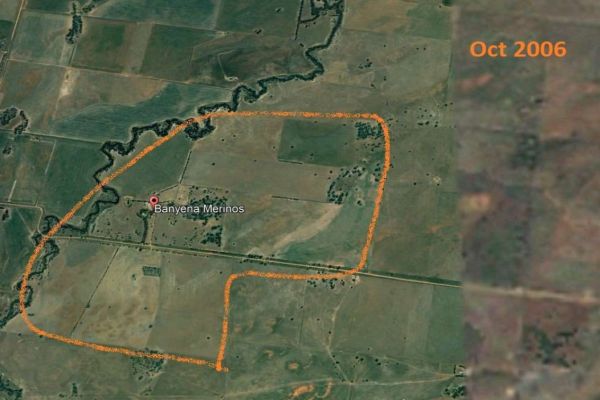
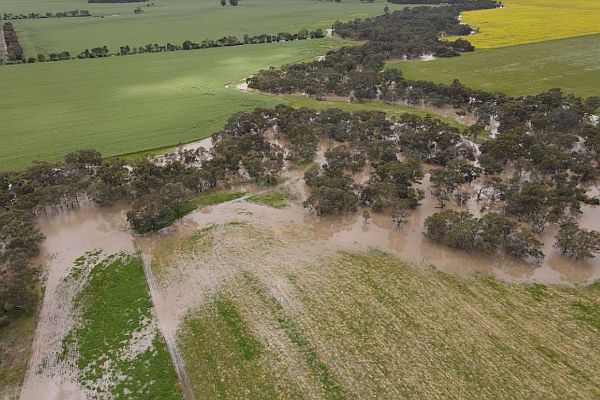
First steps – restoring the farms’ natural values
Prue discussed the challenges of running a viable farming operation whist recognising the need to protect and restore the natural values of the land.
Protect remnant vegetation along the Richardson River and remnant black box swamps
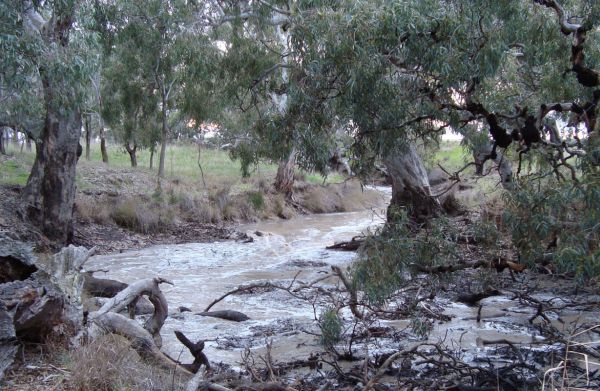
Establish shelter belts
Shelter belts were established along fence lines and roadsides. Prue pointed out the first shelter belts were only 2 rows wide, comprised mainly trees but over time the shelter belts have increased to 30 m wide comprising 5 rows with a focus on including understory species.
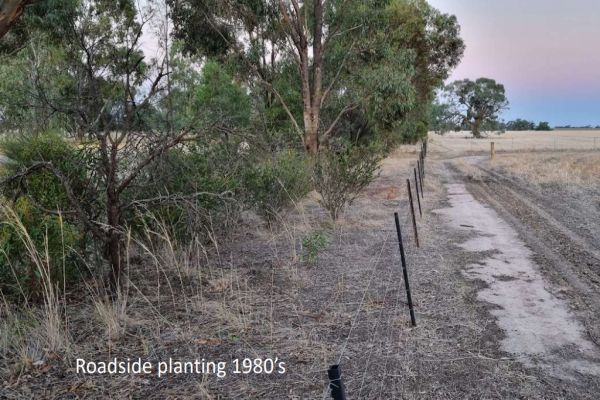
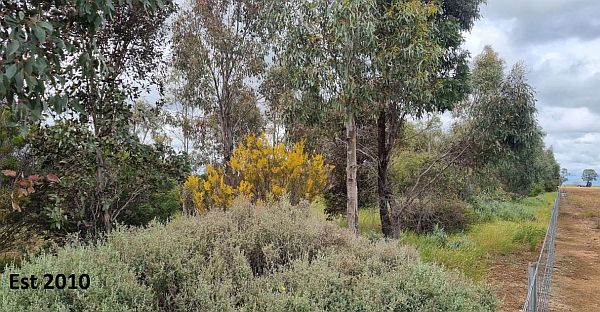
Protection of remnant habitat trees
These trees provide important linkages for wildlife to move around the farm as well as to and from the river and swamps. Prue pointed out the remnant Buloke trees were being heavily impacted upon by grazing so stands of bulokes’ and individual paddock trees have been protected.
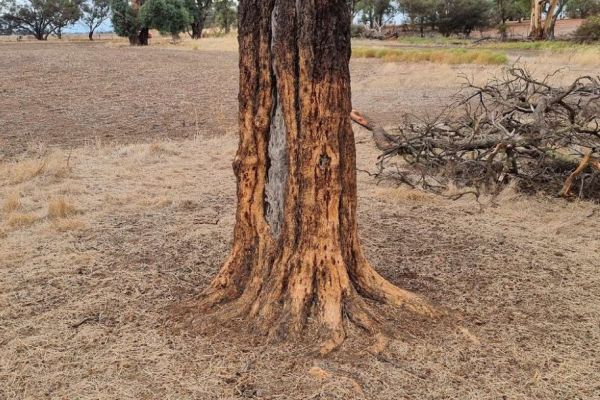
Typical damage to a remnant habitat tree which over time could lead to the loss of the tree through ringbarking by stock.
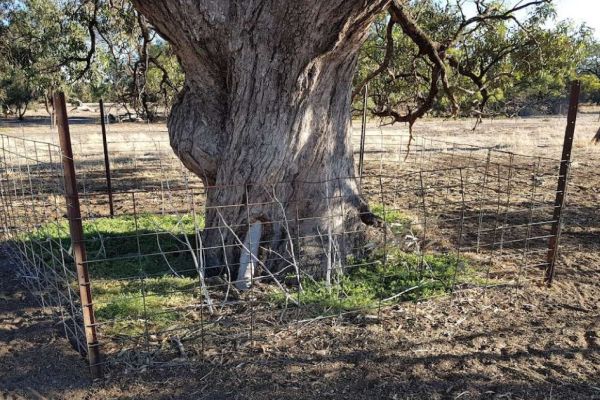
The farm today
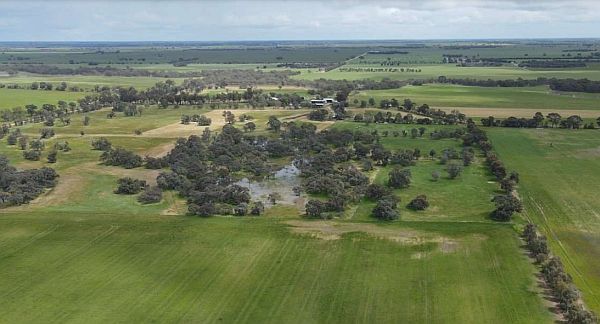
Additional habitat enhancements
Prue spoke about the establishment of a permanent water source within the fenced off stands of black box, works commenced in 2017. The pond was created to hold permanent water being replenished as part of the farms water allocation from Goulburn Murray Water. The site was landscaped with old trees and revegetated with local plants.
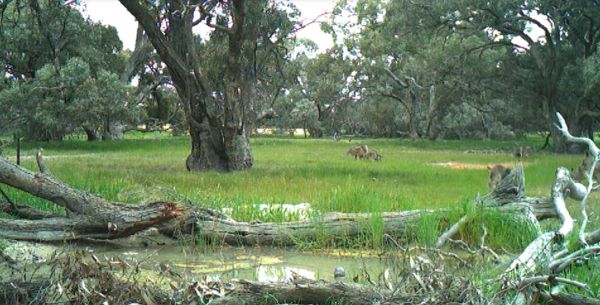
The created wetland and associated plantings and habitat enhancements now supports increased biodiversity to the property. Prue has been able to monitor the diversity of bird life through the use of a covert camera. The camera has detected a much higher use of the pond than was realised.
Studies of flora within the 4-ha fenced off area found 62 species of native flora with 6 species being listed as threatened.
Regenerative farming
Prue spoke about the transition to regenerative farming which included a 2-day seminar by Charles Massey. The McAllister’s son, Dougal took over management of the farm and has incorporated regenerative farming to improve soil health.
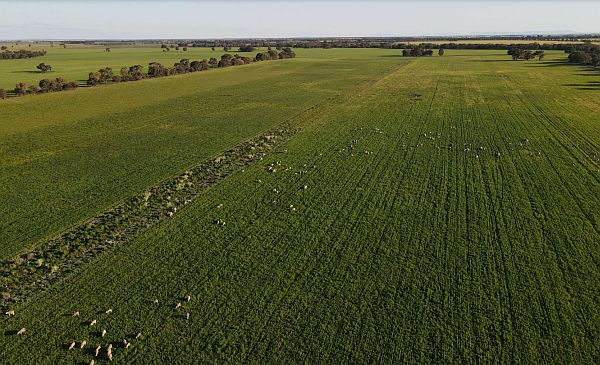
On-going tree planting of wide shelter belts has continued with the aid of Landcare grants and cool burning of grasslands is being introduced as part of the management of the fenced-off black box regenerative area which also contains the wildlife pond.
Regenerative farming has opened up new opportunities to engage with a variety of leading thinkers on farm management. A Natural Capital Accounting Research Project with Latrobe University has been established.
Cropping; what it takes to keep it alive
Dougal McAllister
Dougal spoke about the overall changes in the Wimmera landscape, as farmers have moved away from sheep grazing to cropping in recent years. He pointed out that much of the landscape consists of monocultured crops with little remnant vegetation.
The cropping goal is to produce a plant but the process has little regard for on-going soil health. During the stages of crop establishment and growth the process involves applications of herbicides and fungicide, snail and mouse baiting and insecticides. The soil is treated with Urea and tilled.
Dougall spoke about the importance of transitioning to a more sustainable regenerative cropping program focusing on soil life.
Soil health
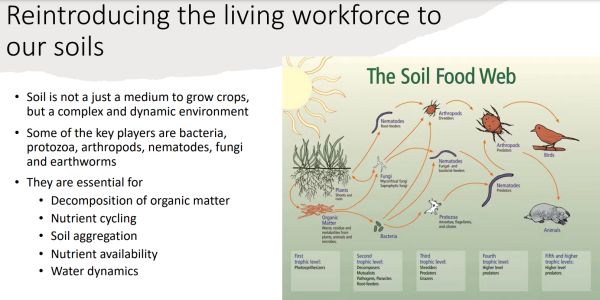
Crop growth needs more that nitrogen and phosphorus
Dougal spoke about the relationship between soil health and plant growth. Plant exudates are organic compounds released by the roots into the soil. In healthy systems, up to 40% of the plants sugars can be released back into the soil which feeds bacteria and other beneficial organisms. This in turn helps support healthier plants which are less prone to environmental stress and reducing the need for chemicals.
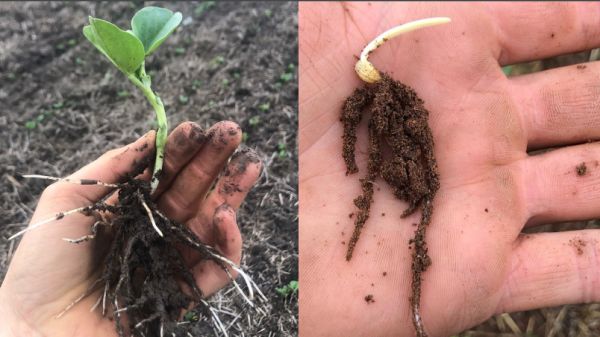
A healthy root system shown above with furry, rastafarian roots (a sheath of soil around the roots), demonstrating a good rhizosphere).
Biological seed coating
Seed dressing is applied at the day of sowing, at a rate of 20L/tonne. Dougal uses a variety of components in the formula:
- 5L/tonne of Nutrisoil worm juice (Nutri-Life BIO-N which is a bacteria that converts atmospheric nitrogen to ammonium nitrate)
- Nutri-Life Tricho-Sheild is a fungus which predates on up to 30 known plant diseases. It increases uptake of fertilizers and can reduces the need for nitrogen inputs by up to 30%
- BAM (beneficial anaerobic microbes) which can be made on site. It has the ability to help colonise compacted soils and reinvigorate the soil food chain.
- Other supplementary additives for good microbial growth include 5kg kelp powder, 2.5 kg Fulvic Acid, Molasses, Molybdenum, Zinc and Manganese.
Humic acid
Dougal spoke about the use of Humic Acid which chelates with phosphorus ions, increasing their solubility and availability for plant uptake. Humic Acid enhances the mobility of phosphorus in the soil, ensuring better access to plant roots. It also buffers the soil pH and enhances soil microbes for improved plant growth.
Foliar spraying urea
The process used by Dougal involves application in a liquid for by boom spraying. It allows for faster nutrient uptake through plant leaves, leading to quicker responses to nutrient deficiencies.
Protozoa Tea
The mix of protozoa tea is made up on farm. Dougal discussed the recipe which is applied at 1L/Ha within 24hours of being made up. The protozoa tea is beneficial for foliar spraying in poor or compacted soils to speed up the cycling of nutrients.
Monitoring of plant growth
Dougal has been monitoring the soil health this season by observing the soil bio-life and root structure of plants in the crop. Dougal also uses a miro bio meter which measures the microbiological count (MBC) as well as the fungi / bacteria ratio.
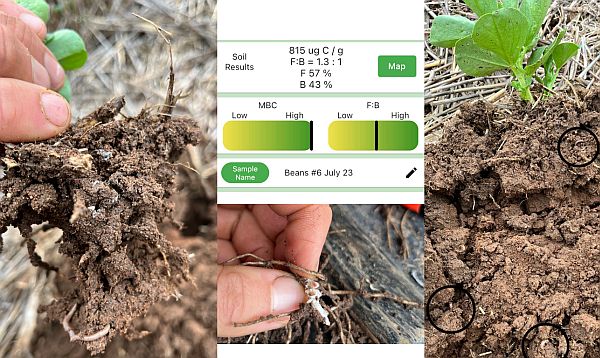
Dougal pointed out that monitoring of a separate wheat crop and barley crop revealed different results which had a lower MBC, but Dougal was happy as they were good healthy crops.
Summary
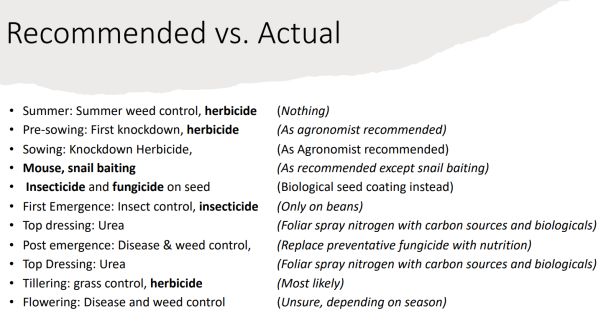
Dougal spoke about how the use of regenerative agriculture can be employed to negate or replace the application of some of the traditional cropping techniques, building a more healthy and resilient soil system for improved crop growth.
Dougal acknowledged the assistance provided by parents, also Andrew Sneyd (Hybrid-Ag), Joel Williams (Integrated Soils), Graeme Sait (Nutri-Tech Solutions), George Hepburn (Nutrien) as well as neighbours and other regen ag farmers.
Key points from questions
There have been no leaf burn issues with applying foliar spray as it is applied at a small rate of 25kg/ha but Dougal pointed out the need to avoid sunny or windy conditions.
The use of BAM (beneficial anaerobic microbes) also helps the plants in the uptake of urea.
Landcare partnerships - the Bass Coast Landcare Network model for success
Dave Bateman - Executive General Manager Landcare Facilitator for Bass Coast Landcare Network
Dave has worked for Bass Coast Landcare for 16 years; he has a passion for meeting people and helping achieve outcomes for the environment.
Bass Coast Landcare Network (BCLN) is a community-based not for profit incorporated organisation/charity, overseen by a member-based Board, providing substantial Landcare/NRM, Sustainable Agriculture and Education within the Bass Coast region and beyond.
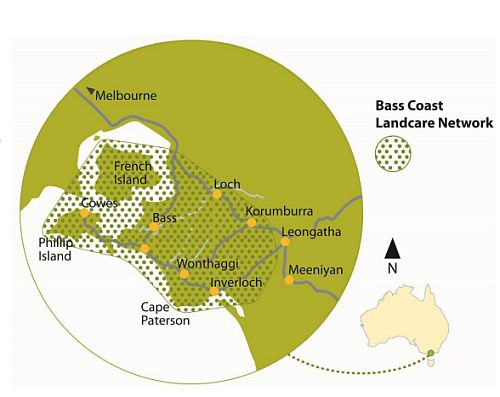
BCLN began in 1987 with 2 Landcare groups and expanded to a network of 10 Landcare Groups in 2004, it now covers 2 CMA areas with over 1,000 members. BCLN has a diverse team of around 25 staff involved in Natural Resource Management, Sustainable Agriculture, Ecosystem services and Education.
Outcomes 2008 to 2022
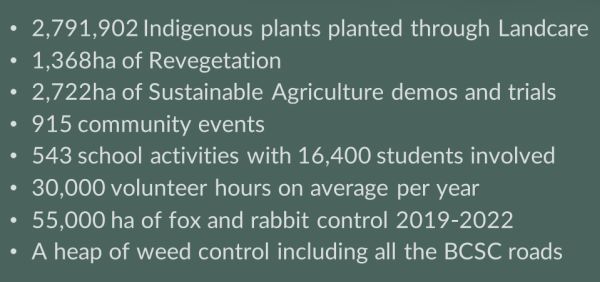
Biodiversity and farm benefits generated through BCLN
Dave spoke about how the BCLN contributes to biodiversity on farms through whole farm planning with planning of better internal fencing and revegetation which provides more shade and shelter for stock and the opportunity for rotational grazing. Dave pointed out that BCLN has experienced project officers who work with landholders to undertake whole farm planning and support them in seeking funding for implementation.
The advantages of whole farm planing leads to a more resilient agricultural system, being able to support increased biodiversity and an overall healthier environment.
Dave pointed out that fencing-off the waterways is the number 1 priority, leading to better water quality, reduced risk of stock loss, reductions in sediment and nutrient and less erosion.
Revegetation
The Bass Coast is a high rainfall area which enables planting from May to October.
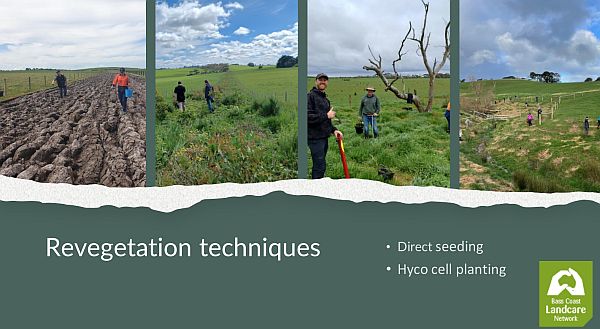
Benefits of community planting days
Dave spoke about the fact that Landcare is not only about getting trees in the ground. It is also about having a fun time and getting people involved with each other and the natural environment.
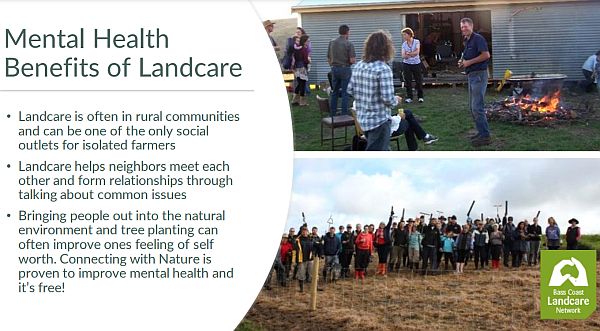
What makes BCLC a Strong Network
Dave spoke about some of the factors which have made BCLN a success. The team invests time and values relationships and partnerships with people, groups and organisations. Key partnerships exist with the Bass Coast Shire, CMAs, water authorities, Bunurong Land Council and other non for profits such as Greening Australia, Greenfleet. Corporate sponsorships also play an important role.
Maintaining good connections between the Board, Landcare Groups and staff is very important. Dave spoke about the importance of valuing staff and having fun through social events such as community planting days.
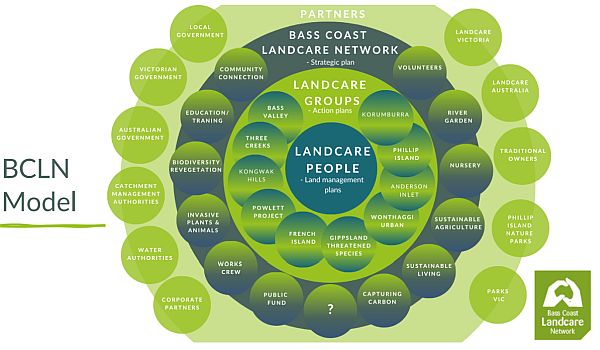
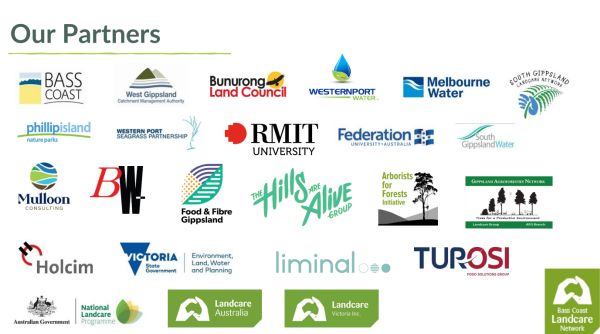
BCLN has partnerships with the Traditional Owner Groups through the Bunurong works team and through cultural inductions which has multiple benefits for the Landcare Community.
Keys to success
Dave spoke about the importance of:
- An innovative and productive volunteer member-based Board
- A great team of facilitators and project officers
- An innovative on-ground works crew
- Sharing of fun and food at all meetings
Works crew
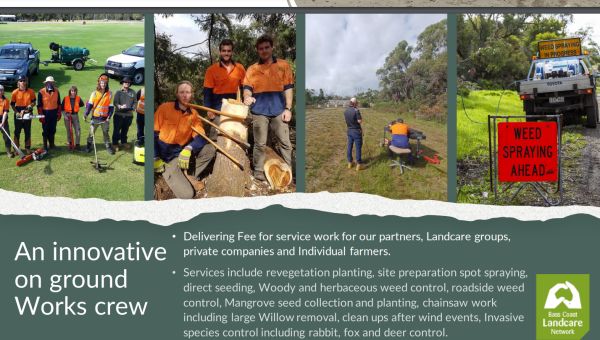
The NRM Team - organise community planting days, run educational programs and work with landholders to protect and restore habitats for native species, improve waterways and water quality.
The Education Training and Communications Team are focused on delivering the Environmental Detectives Program which involves going out to schools and engaging with students in learning about how to care for the environment and engage in planting days. Other activities include the Bass Coast Sustainability Festival, training for secondary students in pathways to Agriculture and Horticulture as well as communicating BCLN to the community.
The Sustainable Agriculture program involves farmer discussion groups, field days, landowner advice and advocacy. The service enables farmers to go to the BCLC office as a one stop shop to discuss ideas and seek advice on farm management and revegetation.
BLING - Bass Coast Landcare Indigenous Plant Nursery is part of BCLC and grows up to 130,000 native plants per year. Around 20 volunteers are part of the nursery.
Dave showed some videos which highlight the programs undertaken by BCLC.
From the ground up video
Works crew video
Mangrove restoration in Westernport Bay
Key points from questions
BCLN generally does not guard trees on the mainland (on Phillip island guarding is required due to rabbits and wallabies). Dave has worked out it is more efficient to plant more trees to allow for loss rather than go through the expense and time of guarding.
BCLN has trialled a few alternate methods and products (slasher and apparent) as part of planting preparations but the cost of these has been almost 10 times as much when compared to using Glyphosate and the other products trialled have been less effective. When planting 300,000 plants these costs become significant, so BCLN has decided to use Glyphosate for spot spraying 4 weeks prior to planting unless the landholder requests a Glyphosate alternative. The BCLN crew goes above and beyond in regards to PPE to ensure safety of its team.
Concerns relating to increased fire risk from planting have been minimal in the Bass Coast area but Dave pointed out that planting fire resistant species can be incorporated as an asset management / protection tool.
BCLN has an MOU with Bass Coast Shire to undertake a variety of services. In general terms partnership income across partners makes up about 50% of the funding.
Building relationships with partners and landowners to deliver mutually beneficial outcomes is fundamental to BCLC work.
More information: Bass Coast Landcare
Flora and Fauna supporting Agriculture
Andrew Stewart – Coordinator of the Otway Agroforestry Network
Andrew introduced his presentation by talking about Yan Yan Gurt West farm which is located on the northern fall of the Otway Ranges. The farm is a family operation with an integrated approach of raising 1500 to 1800 prime lambs per year. Andrew spoke about the on-going revegetation of the farm, now focusing on landclass subdivision boundaries, remnant vegetation areas, waterways and dams. 85% of dams have been fenced out and revegetated.
Starting from scratch
Andrew showed some slides of what the farm looked like in the 1970’s and 1980’s.
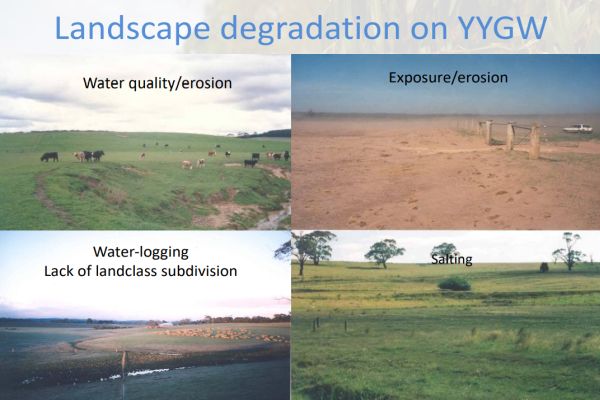
Develop a whole farm plan
In order to undertake restoration of the property, Andrew and his family commenced development of a whole farm plan in 1991. The process involved looking at Ecological Vegetation Classes (EVC’s) of vegetation that would have once existed on the property. Three EVC’s were identified; Swamp Riparian Woodland, Grassy Woodland and Lowland Forest. This information provided a basis from which to work from.
An analysis of Land Class Subdivisions was carried out as part of the whole farm planning process with 5 Land Classes being identified; Light sandy loam flat or undulating, Light sandy loam-steep, Salt effected, Loam – undulating and Heavy clay loam flat.
Farm restoration
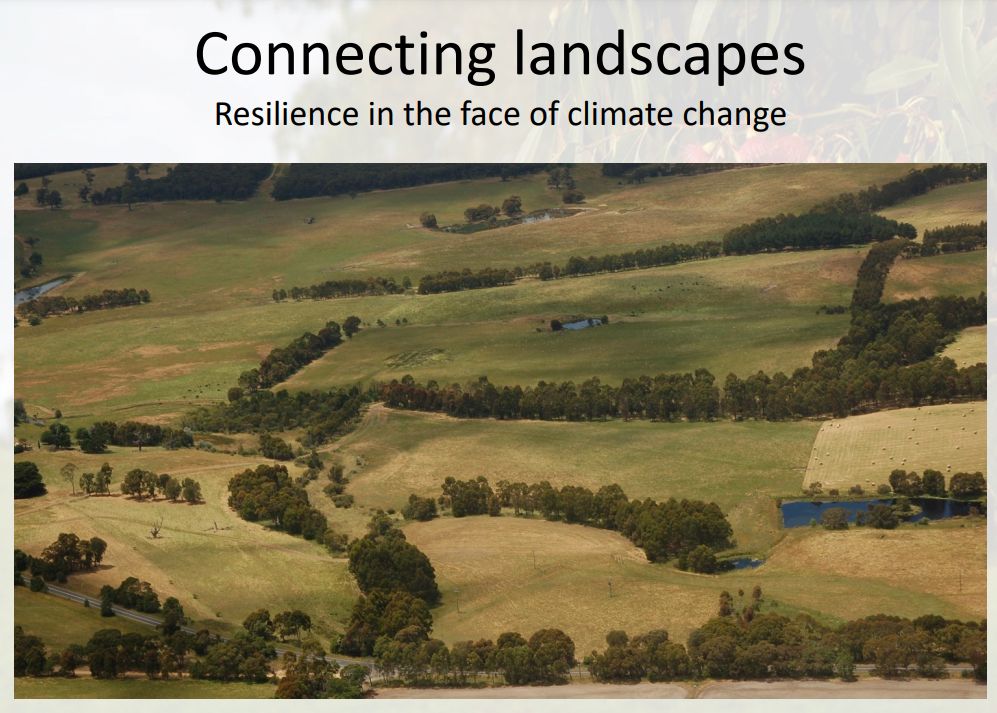
Andrew also pointed out that some of the plantings have been carried out for agroforestry purposes to further enhance diversified productivity of the farm.
Landscape change and benefits
Andrew spoke about some of the plantings and showed several before and after images which demonstrated that landscape change can be achieved quite quickly if you have good species selection and good weed control.
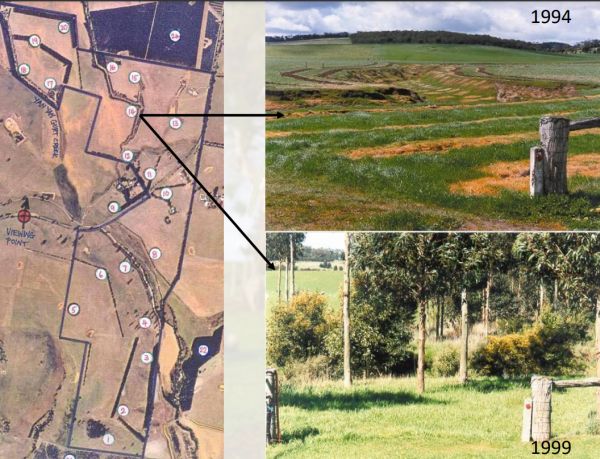
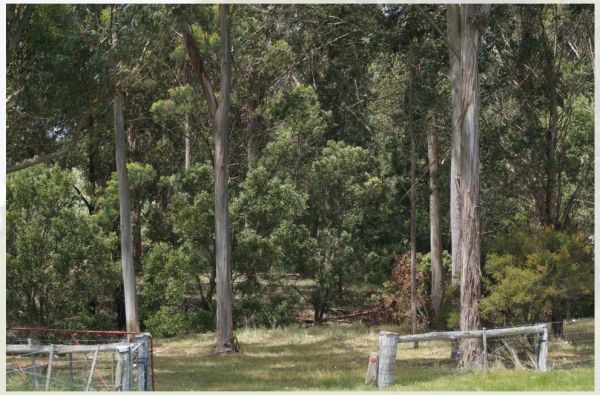
Andrew showed some images that demonstrated recovery of salt affected areas. He also emphasised that the plantings now provide some very good haven for stock, for example, during shearing areas are available for shelter in case of bad weather.
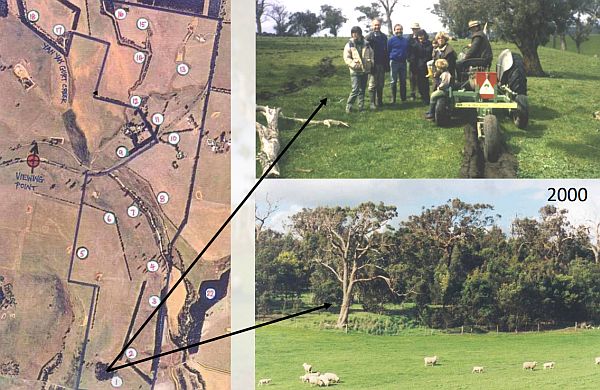
Andrew highlighted results from a Corangamite CMA study found a high level of predatory spiders in the revegetated area which can have a beneficial impact on the control of red-legged earth mites.
Sweet Bursaria Bursaria spinosa is included in the revegetation as it supports a parasitic species of wasp which can aid in the control of cockchafer grubs.
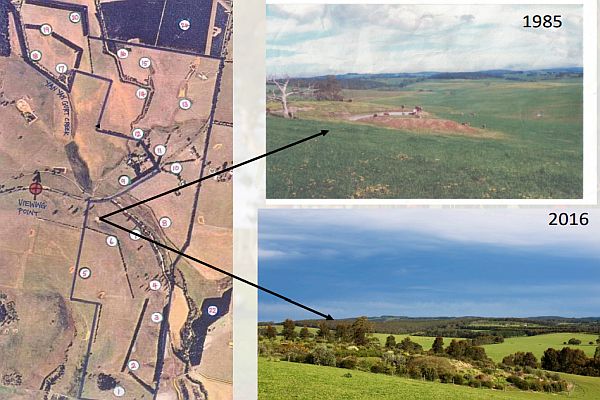
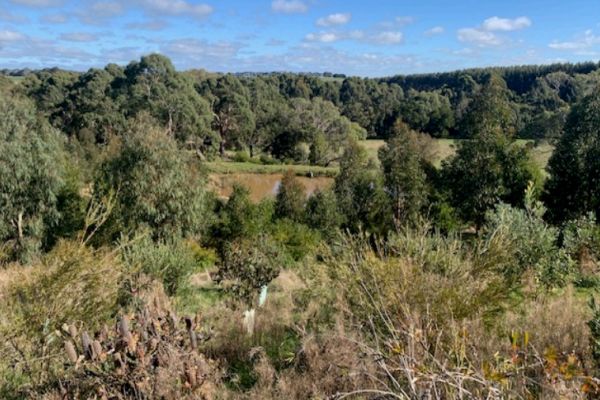
Production of honey is now integrated into the farm; plantings have provided for increased flowering and shelter for the bees which also serve as pollinators.
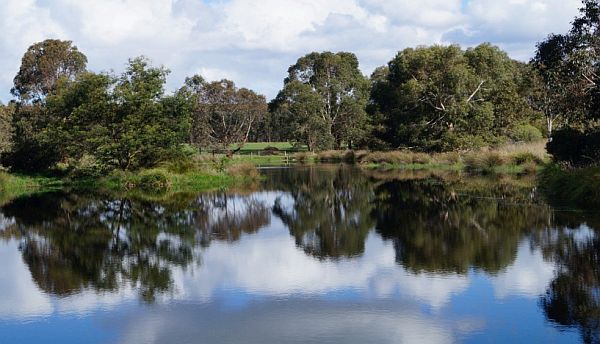
The farm now has a 23 km interface of trees to pasture. Andrew has noted the farm environment is now warmer in the winter and cooler in the summer than it used to be.
Biodiversity
Andrew spoke about the increase in biodiversity on the property as a result of all the plantings which included about 120 species of trees and shrubs.
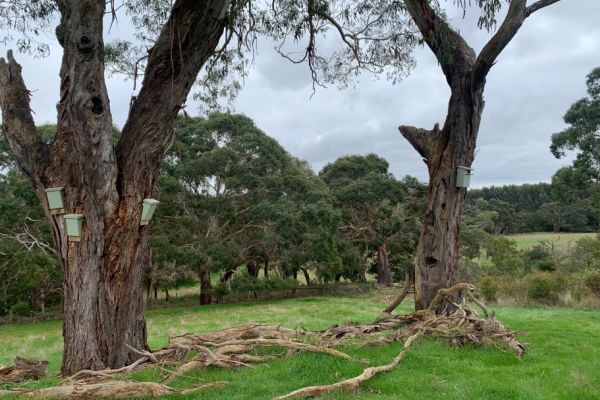
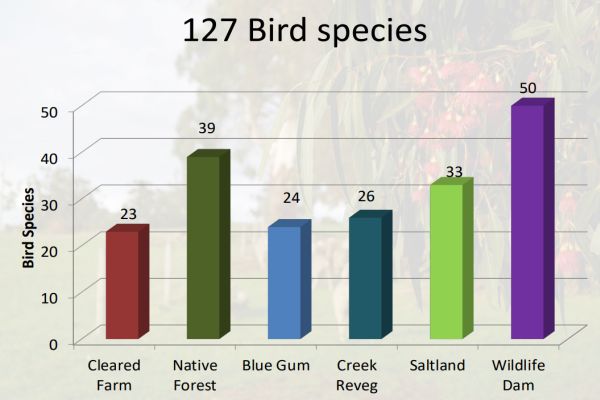
Bird photography is now an interest amongst family members. A further revegetation initiative is that where an old dead tree is located a new tree is planted. When a paddock is being prepared for sewing any old logs are relocated near an existing dead tree to create habitat clusters for wildlife. These areas have been very beneficial for skinks.
Agroforestry
Andrew discussed how the farm incorporates agroforestry as part of the farm’s integrated and diversified production.
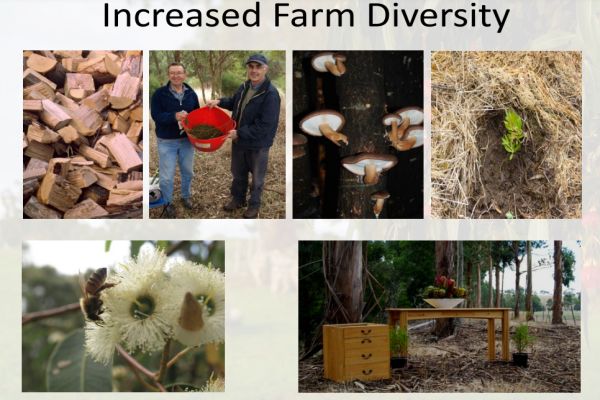
Farm production
Livestock products (67 tonnes/yr) Lambs -1500-1800 per year, Meat & by-products - 60,000 kg, Skins - 1,500, Wool - 6000 kg greasy wool.
Tree products (208 green tonnes/yr)- Softwood sawlogs – 38 t (12 t/ha/yr), Hardwood sawlogs – 50 t (5 t/ha/yr), Hardwood pulp logs – 120 t (15 t/ha/yr).
Other products - fuel, poles, Xmas trees, shiitake logs, seed, flowers, bushfoods.
Andrew highlighted that the farm has gone from 3% woody vegetation in 1980’s to 18% with re-vegetation, with no loss of productivity. Plus, there is now extra production from trees, other products and a massive increase in the environmental amenity of the farm. The farm is also carbon neutral as the carbon uptake by the trees is balanced against the carbon from stock.
Andrew finished up by talking about the Otway Agroforestry network and the Yan Yan Gurt Creek catchment where many farmers are members of the Otway Agroforstry Network and the East Otway Landcare Group who are contributing to the overall revegetation of the catchment, which has a positive effect on reducing erosion and improving water quality leading into the Barwon River.
Between 1990 to 2018 the vegetation cover in the catchment has gone from 6% to 23%. Riparian vegetation has increased from 1.5 km to 18 km and the timber production area has increased from 13 ha to 252 ha.
Key points from questions
Andrew and his family feel they can raise the woody tree cover to 20% on the farm, beyond that level it could be a competition to agriculture rather than an enhancement.
Incorporating agroforestry into farm revegetation can increase carbon neutrality faster than standard planting because the trees selected for agroforestry have higher growth rates and large girths. When trees are harvested the carbon is stored off site in timber products and a new tree is planted.
Planting trees on farms does not necessarily increase fire risks. Trees can reduce wind speed and slow grass fires. Also, the species of trees used around assets needs to be considered with species of deciduous trees, such as oaks, being favoured to serve as ember catchers and to reduce wind speed as well as protection from radiant heat. Smoothed barked gums like the spotted gum can also be less inclined to burn from the understory to the overstory. However, on a catastrophic day anything will burn.
To learn more about Yan Yan Gurt West farm, tours of the farm are conducted as part of the farm business. Tours can be tailored to suit the interests of individual groups. Recent tours include, the Royal Botanic Gardens Victoria and Cranbourne Friends Group.
More information: Otway Agroforestry Network where a podcast series can be accessed.
Otway Agrosorestry Newsletter - July 2023
Building an Australian Food and Land and Stewardship System
Prof. Snow Barlow & Winsome McCaughey AO - Co-directors at Baddaginnie Run Winery
Winsome introduced the presentation by acknowledging the Elders of the Taungurung lands, where the farm is located. Winsome spoke about her deep connection to the land, with her grandchildren now being 7th generation farmers.
Being a former CEO of Greening Australia, Winsome has a tremendous understanding of the degradation to natural landscapes, she highlighted the total interdependence of biodiversity and farm productivity.
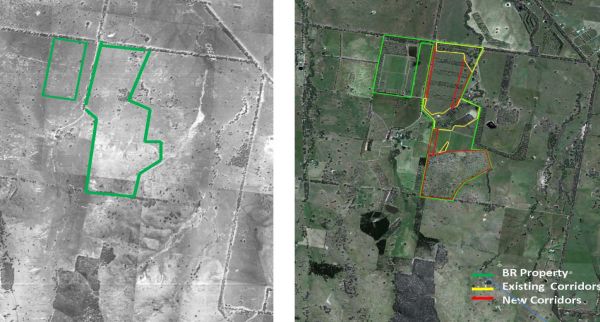
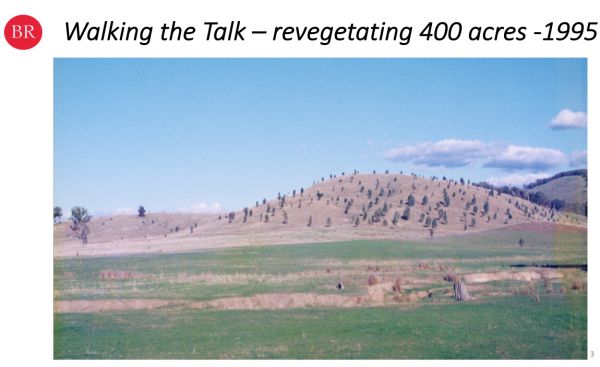
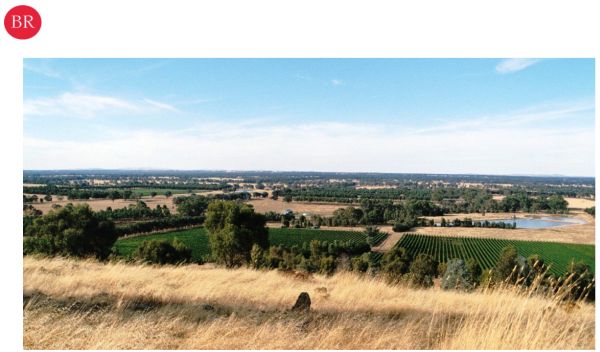
Winsome and Snow both spoke about creation of a whole farm plan which incorporates biodiversity and production from farm forestry and vineyards. A major grant was achieved from the Clean Energy Council – Biodiversity Fund in 2011 to undertake the ‘Roadsides to Ranges- Baddaginnie Run bio-corridor for biodiversity, profitability & carbon credits -2012-2018’ project.
Snow spoke about the proposed outcomes of the project:
- A web of sustainable bio-corridors, linking upland forest reserves with lowland original roadside vegetation and incorporating numerous tracts of original and replanted vegetation including 30 hectares to be permanently reserved.
- A Bio-Farm Management Plan integrating sustainable farming activities with bio-plantings and Financial Plan integrating income generated from farm products and carbon credits.
- A learning centre that demonstrates good practice in managing biodiversity, connectivity and carbon storage integrated with productive profitable farming enterprises.
- An accessible demonstration 'Corridors Hub' stimulating wider, multi-property bio/carbon-storage/farming corridors across the Violet Town Plains and similar southern Australia farming areas.
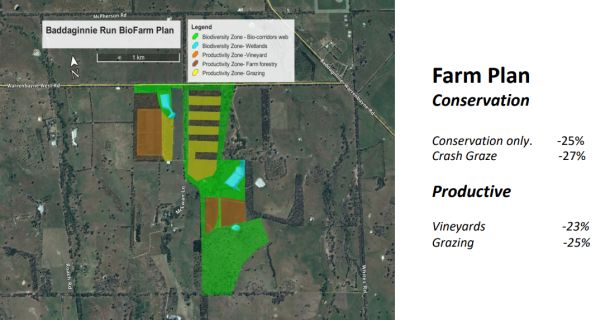
(Green) - biodiversity areas and linked corridors, (light brown) – vineyards, (dark brown) - farm forestry areas, (yellow) – grazing zone, (blue) – wetlands.
25% of the 160 ha is totally conservation with zero grazing, 27% of the farm area is short-term crash grazed, which includes some of the bio-corridors, 25% is vineyards and 25% grazing.
Farm Productivity - Adding Value from Biodiversity
Snow discussed how management of the farm has incorporated biodiversity to enhance farm productivity. The winery is at the centre of farm’s production. No herbicides are used which opens up opportunities to value-add by producing a unique quality wine which incorporates wild fermentation. The product is a wild ferment Shiraz. The natural yeasts are on the grapes which are grown in sync with the surrounding environment.
Selling wine as a boutique wine producer is not about mass production but more about quality and telling the story of how the wine was made in harmony with nature.
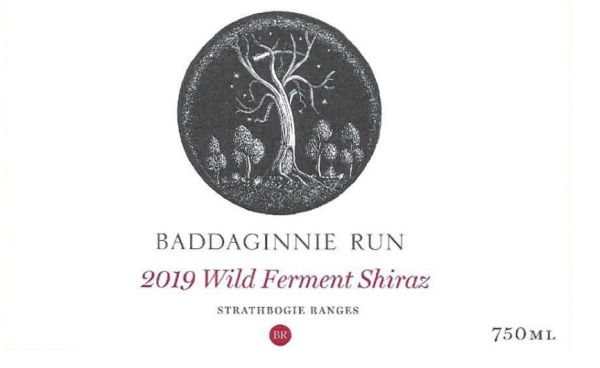
Roadsides to Ranges Roundtable - 2017
Snow spoke about a 2-day workshop that was held in 2017. The roundtable was organised to explore and share learnings from experiences gained from the ‘Roadsides to Ranges- Baddaginnie Run bio-corridor for biodiversity project. The workshop involved 20 leading Australian experts in biodiversity and agriculture with 20 district farmers.
Winsome explained the principal outcomes which came out of the roundtable workshop.
- Recognise our iconic Australian landscape and functioning ecosystems are the foundation of Australia’s national identity, culture and whole way of life.
- Recognise biodiversity and functioning ecosystems underpin Australia’s farm productivity and food security; and that loss of these plus climate change threaten our agricultural productivity and whole food supply chain.
- Recognise that the clearing of native vegetation from 90% of Australian farm landscapes and its replacement with intensive agriculture has had devastating impacts on functioning ecosystems, soils, biota, biodiversity and habitat and more.
- Recognise that regenerating native vegetation and adapting sustainable, resilient agricultural practices is crucial to the restoration and maintenance of functioning ecosystems and to carbon storage.
- Recognise or generation’s responsibility to future generations to put in place major policies and plans that support on-going regeneration of biodiversity and ecosystems.
- Recognise the exciting new knowledge and practices being developed and demonstrated by leading-edge Australian farmers who are simultaneously regenerating biodiversity, restoring ecosystems, storing carbon and improving productivity/ profitability on integrated bio-farm landscapes; capture and research the efforts; create evidence-based knowledge from it; and communicate it to all Australian farmers and the community.
- Recognise that food prices must take account of the impact of production on natural resources, plus the costs of putting back what’s taken from the land and of managing climate change; and, that Australia’s real competitive agricultural advantage lies in producing carbon neutral, high-value goods from safe, green provenances.
Building an Australian Food and Land and Stewardship System
An Australian Culture celebrating Nature, Food and Landscape and engages all Australians as land stewards.
Evidence-based Information based on R&D Programs and on-farm experience of the productivity gains from improving biodiversity, sequestering carbon and sustainable practises (specific to sectors and localities).
Farm Capacity Development and Planning for Carbon Neutrality: knowledge and tools for integrating carbon sequestration / biodiversity regeneration practises while improving profitability across Catchments.
Coordination & Recalibration across Multiple Agencies: of food, agriculture and biodiversity.
Refocussed Regulatory Mechanisms including food standards and labelling; environmental verification systems, that support rural communities to develop shared sustainable enterprises.
Targeted Incentives (public and private) that reward carbon sequestration and biodiversity enabling citizens to recognise the environmental impact of food production in trade and supply chains.
A National Accounts Framework that puts a real $ value on environmental impacts of food production.
A National Sustainability Indices & Monitoring System that integrate meta data from existing sources
Winsome went on to explain how the Baddaginnie Run Winery incorporates Caring for Country principles: Creating exceptional wine – replacing native flora – restoring healthy ecosystems – producing quality grapes - From the Land for the Land.
View notes from previous SWIFFT seminars


